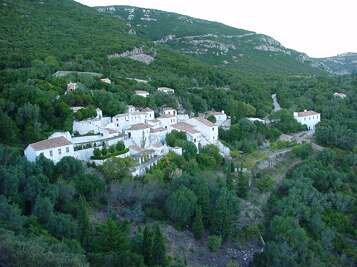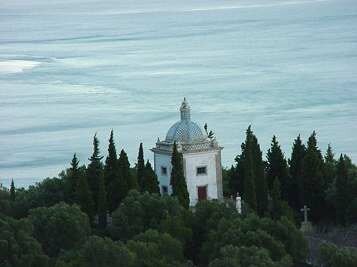Arrabida
Convent
[see map]

As
always happens with almost every one of the litoral sanctuaries, so the
foundation of the Arrábida Convent is wrapped up in a pious legend. It began in
1215, when the english merchant Haidebrant brought in his ship an image of Our
Lady with Jesus infant, carved in stone and retired from the chapel of a
Benidictine Convent. The image disappeared during a storm in portuguese waters
and with Lisbon at sight. However, the ship succeded in turning the Espichel
Cape, and arriving finally to Alpertuche, were the sea was peaceful. The sailor,
resting from the storm, sighted an intense light in the top of the Arrabida
Mountain, which he climbed up amid the thicket. He soon found the miraculous
image. He then sold all his possessions and ordered the construction of a chapel,
where he proposed himself to live alone. Some decades past, the Duke of Aveiro,
D. João de Lencastre, asked the Superior General of the Franciscan Order to
send a small community of friars to live in the Arrabida retreat. The duke,
visiting Guadalupe, contacted an important spanish nobleman, to whom he
explained his idea. This nobleman was to come the famous Friar Martinho de Santa
Maria, after having founded the Arrabida Convent. The invitation was so accepted,
and the recovering of the built areas (with the Memory Chapel) was studied
afterwards, together with the utilization of the surrounding grounds. The New
Convent is located in the hillside, its whiteness animating the prevailing green.
About 1.5 kilometers of the convent complex, we can see the small chapel of Bom Jesus. This temple presents a singular architecture and decoration. The reasons and the sense of this building are frequently object of varied interpretations. The octagonal form of the chapel and of the altar is one of the controversial matters. The building of the chapel was ordered by D. Álvaro de Lencastre in the 14th century, and the author of its plan was the friar Afonso da Piedade.

There
are several stone figures - today very mutilated - that flank the access to the
temple yard. The chapel is topped by an arched roof, with a minaret and glassed
tiles covering. The four doors that opened to the celebrations area are located
in the superior floor, to where lead two flights of steps. The altar is
quadrangular, of artistic design and good carving, formerly gilt, and tradition
says that here have been simultaneously celebrated four masses. A great
tabernacle, also with four porticos, holds within a smaller one, where there was
an image of a small Jesus infant.
your opinion